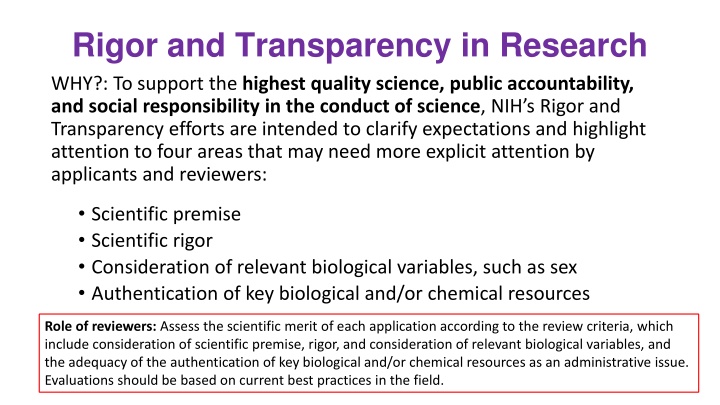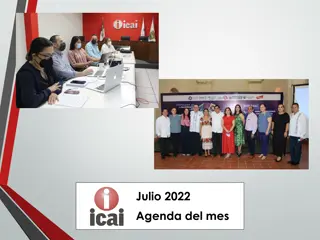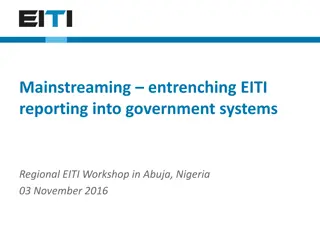Enhancing Research Quality through Rigor and Transparency Initiatives
NIH's Rigor and Transparency efforts aim to uphold the highest standards in research, ensuring scientific premise, rigor, consideration of relevant biological variables, and authentication of key resources. Reviewers play a critical role in assessing these aspects to support robust and accountable scientific endeavors. Guidance is provided on evaluating scientific premise, scientific rigor, and addressing relevant biological variables to enhance research quality and reproducibility.
Download Presentation

Please find below an Image/Link to download the presentation.
The content on the website is provided AS IS for your information and personal use only. It may not be sold, licensed, or shared on other websites without obtaining consent from the author.If you encounter any issues during the download, it is possible that the publisher has removed the file from their server.
You are allowed to download the files provided on this website for personal or commercial use, subject to the condition that they are used lawfully. All files are the property of their respective owners.
The content on the website is provided AS IS for your information and personal use only. It may not be sold, licensed, or shared on other websites without obtaining consent from the author.
E N D
Presentation Transcript
Rigor and Transparency in Research WHY?: To support the highest quality science, public accountability, and social responsibility in the conduct of science, NIH s Rigor and Transparency efforts are intended to clarify expectations and highlight attention to four areas that may need more explicit attention by applicants and reviewers: Scientific premise Scientific rigor Consideration of relevant biological variables, such as sex Authentication of key biological and/or chemical resources Role of reviewers: Assess the scientific merit of each application according to the review criteria, which include consideration of scientific premise, rigor, and consideration of relevant biological variables, and the adequacy of the authentication of key biological and/or chemical resources as an administrative issue. Evaluations should be based on current best practices in the field.
Scientific Premise Scientific Premise: Guidance for Reviewers : Guidance for Reviewers GOAL: Ensure that the underlying scientific foundation of the project concepts, previous work, and data (when relevant) is sound. Pertains to the underlying evidence/data that supports the project Address under Significance in the Critique Template Addition to the review criteria: Is there a strong scientific premise? Specifically, has the applicant: Provided sufficient justification for the proposed work? Cited appropriate work and/or preliminary data? Appropriately identified strengths and weaknesses in prior work in the field? Proposed to fill a significant gap in the field? OR has the applicant explained why this is not possible so far?
Scientific Rigor Scientific Rigor: Guidance for Reviewers : Guidance for Reviewers GOAL: Ensure a strict application of scientific methods that support robust and unbiased design, analysis, interpretation, and reporting of results, and sufficient information for the study to be assessed and reproduced. Give careful consideration to the methods and issues that matter in your field. Pertains to the proposed research Address under Approach in the Critique Template Addition to review criteria: Are there strategies to ensure a robust and unbiased approach, as appropriate for the work proposed? Possible considerations, if appropriate for the scientific field and research question, include plans for: methods / techniques determining group sizes analyzing anticipated results reducing bias, proper controls ensuring independent and blinded measurements improving precision and reducing variability including or excluding research subjects managing missing data
Relevant Biological Variables Relevant Biological Variables: Guidance for Reviewers : Guidance for Reviewers GOAL: Ensure that the research accounts for sex and other relevant biological variables in developing research questions and study designs. The ways in which sex and other biological variables need to be accounted for will differ across research questions and fields of study. Pertains to the proposed research Applies to studies in vertebrate animals and/or human subjects Address in Approach in the Critique Template Addition to review criteria: Are there adequate plans to address relevant biological variables for studies in vertebrate animals or human subjects? Consideration of sex is required in all studies involving human subjects or vertebrate animals (see next slide). Specific considerations to assess include: Applies broadly to all biological variables relevant to the research such as sex, age, source, weight, or genetic strain.) Has the applicant considered biological variables, such as sex, that are relevant to the experimental design? If not, is this justified? Will relevant biological variables be controlled or factored into the study design appropriately? If not, is this justified? 4
Sex as a Biological Variable (SABV) Sex as a Biological Variable (SABV) Consideration of sex, included under the umbrella of Relevant Biological Variables , is required in all studies involving human subjects or vertebrate animals. NIH expectations for applicants: If little is known about sex differences, the application should include both sexes. Sufficient numbers should be provided to inform the presence or absence of sex differences. Statistically powered comparisons between sexes may not be warranted. Specific hypotheses about sex differences may not be possible. Findings should be reported separately by sex in progress reports and publications. If sex differences are known not to exist, a strong justification should be provided if the application proposes to study one sex. If sex differences are known, experiments should be designed with appropriate group sizes to detect sex differences. NIH expectations for reviewers: As part of the Consideration of Relevant Biological Variables, assess whether the plans to address sex as a biological variable are adequate (for studies in vertebrate animals or human subjects). If the study involves only one sex, is this justified scientifically? Assess within the context of the research question and current scientific knowledge. 5
Plan for Resource Authentication Plan for Resource Authentication: Guidance for Reviewers Reviewers : Guidance for GOAL: Ensure processes are in place to identify and regularly validate key resources used in their research and avoid unreliable research as a result of misidentified or contaminated resources. Researchers are expected to authenticate key biological and/or chemical resources used in their research, to ensure that the resources are genuine. New Additional Review Consideration Authentication of Key Biological and/or Chemical Resources: For projects involving key biological and/or chemical resources, reviewers will comment on the brief plans proposed for identifying and ensuring the validity of those resources. Rate as acceptable/unacceptable in new box in Critique Template (provide brief explanation if unacceptable) Does not affect criterion scores or overall impact score
Reviewing Rigor and Transparency of Research: Reviewing Rigor and Transparency of Research: RPG Applications RPG Applications Affect overall impact score? Where do I include it in my critique? Applies to which applications? Where will I find it in the application? Addition to review criteria Is there a strong scientific premise for the project? Research Strategy (Significance) Scientific Premise All Significance Yes Are there strategies to ensure a robust and unbiased approach? Research Strategy (Approach) Scientific Rigor All Approach Yes Are adequate plans to address relevant biological variables, such as sex, included for studies in vertebrate animals or human subjects? Consideration of Relevant Biological Variables, Such as Sex Projects with vertebrate animals and/or human subjects Research Strategy (Approach) Approach Yes Authentication of Key Biological and/or Chemical Resources Project involving key biological and/or chemical resources Additional review considerations Comment on plans for identifying and ensuring validity of resources. New Attachment No
Related review issues: Related review issues: Different research fields may have different best practices for and reach different conclusions about scientific premise and rigor. Assess based on best practices in the field. Page limits have not changed. Be alert for page limit violations (e.g., in Vertebrate Animals section, inappropriate use of appendices or other application sections). Alert the SRO if you see a potential issue. Page limits, cost and time are not valid reasons to disregard attention to these issues. Investigators address rigor and transparency differently (e.g., in labeled sections vs. throughout the research plan). Focus your evaluation on the likely outcome, not grant writing preferences. Rigor and transparency considerations apply to R21 (exploratory/developmental) applications as well as R01 applications. However, preliminary data are not required for R21 applications and the extent to which approach details can be provided may differ. Reviewers should evaluate the scientific merit of these applications, including rigor and transparency, in light of the goals and reviewer guidelines for these activities.
Additional resources Additional resources Rigor and Reproducibility in grant applications (OER site): http://grants.nih.gov/reproducibility/index.htm NIH presentation of background and goals of Rigor and Transparency (video) https://grants.nih.gov/reproducibility/module_1/presentation.html Reviewer Guidance on Rigor and Transparency: http://grants.nih.gov/grants/peer/guidelines_general/Reviewer_Guidance_on_Rigor_and_Transp arency.pdf Consideration of Sex as a Biological Variable in NIH-funded Research http://orwh.od.nih.gov/sexinscience/overview/pdf/NOT-OD-15-102_Guidance.pdf Rigor and transparency do not apply to all applications. See List of Eligible Activity Codes: https://nih-extramural-intranet.od.nih.gov/d/sites/default/files/RigorActivityCodes- 20151006.pdf. Also, certain Funding Opportunity Announcements are exempt from Rigor and Transparency, by request from the ICs. Questions about the NIH policy should be directed to reproducibility@nih.gov























